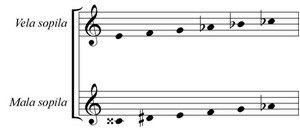Sopila
The sopila (also sopile and sopele, plural sopile) is a double reed instrument that is played in the north of the Croatian Adriatic coast . It is common in the Kvarner Bay and on the island of Krk . In Istria the instrument is called Roženica (plur. Roženice). In the Kastav area there is also the name Tororo .
The sopila is a shawm and is related to similar instruments in the western Mediterranean and Brittany ( piffero , bombarde , tarota ). It is always played in pairs, with a small sopila ( mala sopila ) accompanied by a large sopila ( vela sopila ). The sopila has the characteristic piercing sound of shawm instruments.
Construction, mood and style of play
The wooden body of the Sopila has a conical bore and six finger holes on the top. A double reed ( pisak ) is picked up by a mouthpiece ( špulet ) with little or no pirouette . The play tube ( prebiralica ) ends in a bell ( krilo ). The outside is decorated in several sections with turned rod profiles. In the lower area of the play tube and in the bell there are further tone holes that cannot be grasped. The mala sopila measures around 50 cm, the vela sopila around 65–70 cm. The woods used are olive, box, maple, walnut or fruit woods.
The instruments are tuned in the hexachordic Istrian scale (Croatian: Istarska ljestvica ), which deviates strongly from the major-minor tonality . In the upper part ( vela sopila ) the pitch of the six tones rises alternately by half a tone or a full tone. In two-part playing, the lower voice ( mala sopila ) accompanies you by a major second or minor third , only the closing notes are unison or octave apart . Sopiles are not overblown .
The characteristic two-part tone of the Istrian scale is also used in singing, with the voices imitating the characteristics of the Sopila and often singing on sound syllables. This type of singing and making music is part of the intangible world cultural heritage .
use
Traditionally, Sopila duos played to dance after church, possibly accompanied by singing or tapping the beat with their feet. Its use in worship is also attested. Sopiles are still used at weddings, especially on Krk.
Sopile while dancing (focus on instruments)
Sopile while dancing (focus on dancers)
Web links
- Stjepan Večković (Sva prava pridržana): Sopile - Article at gajde.com (English and Croatian)
- Diana Grgurić: Musical heritage - The variety of musical expression on Kvarner. The Kvarner county tourism office (kvarner.hr; English)
- Article Sopile in Proleksis enciklopedija
- Article Roženice in Istrapedia
literature
- Božidar Širola: Izdaje Etnografski muzej . 1932, p. 67 p .
- R. Pernić: Meštri svirci i kantaduri, istarski narodni pjevači, svirači i graditelji glazbala . 1997.
Individual evidence
- ↑ Sopile. Retrieved May 1, 2014 .
- ↑ Istarska enciklopedija. Retrieved May 1, 2014 .
- ↑ Sopile. Retrieved May 1, 2014 .
- ↑ Istarska enciklopedija. Retrieved May 1, 2014 .
- ↑ UNESCO list for intangible world cultural heritage in Croatia. Retrieved May 1, 2014 .
- ^ Two-part singing and playing in the Istrian scale. Retrieved May 1, 2014 .
- ↑ Istarska enciklopedija. Retrieved May 1, 2014 .
- ↑ Sopile. Retrieved May 1, 2014 .



